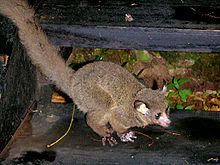Genus of primates From Wikipedia, the free encyclopedia
The greater galagos[1] or thick-tailed bushbabies are three species of strepsirrhine primates. They are classified in the genus Otolemur in the family Galagidae.
| Otolemur[1] | |
|---|---|
 | |
| Brown greater galago (O. crassicaudatus) | |
| Scientific classification | |
| Domain: | Eukaryota |
| Kingdom: | Animalia |
| Phylum: | Chordata |
| Class: | Mammalia |
| Order: | Primates |
| Suborder: | Strepsirrhini |
| Family: | Galagidae |
| Genus: | Otolemur Coquerel, 1859 |
| Type species | |
| Otolemur agyisymbanus | |
| Species | |
|
Otolemur crassicaudatus | |

The diversity of galago species has historically been grossly underestimated. In 1931, only 5 species were recognized, 4 in the genus Galago and 1 in Euoticus, and only one species that would later be placed in the genus Otolemur.[2] In 1979, the genus Otolemur was separated from Galago.[3] By 1986, eleven species were recognized with revamped systemic classification including Otolemur crassicaudatus and Otolemur garnettii.[4] Additionally, O. crassidautus and O. monteiri were recognized as separate species instead of O. monteiri as a nested subspecies.[4] By 2001, 23 species were recognized. Classification by vocalization has particularly become prevalent and helpful as a tool in understanding of these species. All Otolemur species exhibit trailing advertising calls.[2]
The species is found in and around coastal regions of Southern and Southeastern Africa; north from the Juba River in Somalia, southwards through Kenya, Tanzania, Malawi, and Mozambique; west across Zimbabwe, Zambia, and Botswana; southwest to northern South Africa and as far west as Angola and Namibia. For the most part, they live in woodlands and forests, but also are found in sparsely wooded grasslands and even planted city parks and gardens.
| Common name | Scientific name and subspecies | Range | Size and ecology | IUCN status and estimated population |
|---|---|---|---|---|
| Brown greater galago | O. crassicaudatus (É. Geoffroy, 1812) Three subspecies
|
Southern Africa |
Size: 29–38 cm (11–15 in) long, plus 41–48 cm (16–19 in) tail[5] Habitat: Forest, savanna, and shrubland[6] Diet: Gum and sap, as well as fruit and insects[5] |
LC
|
| Northern greater galago | O. garnettii (Ogilby, 1838) Four subspecies
|
Eastern Africa |
Size: 23–34 cm (9–13 in) long, plus about 36 cm (14 in) tail[7] Habitat: Forest[8] Diet: Fruit and insects[7] |
LC
|
Seamless Wikipedia browsing. On steroids.